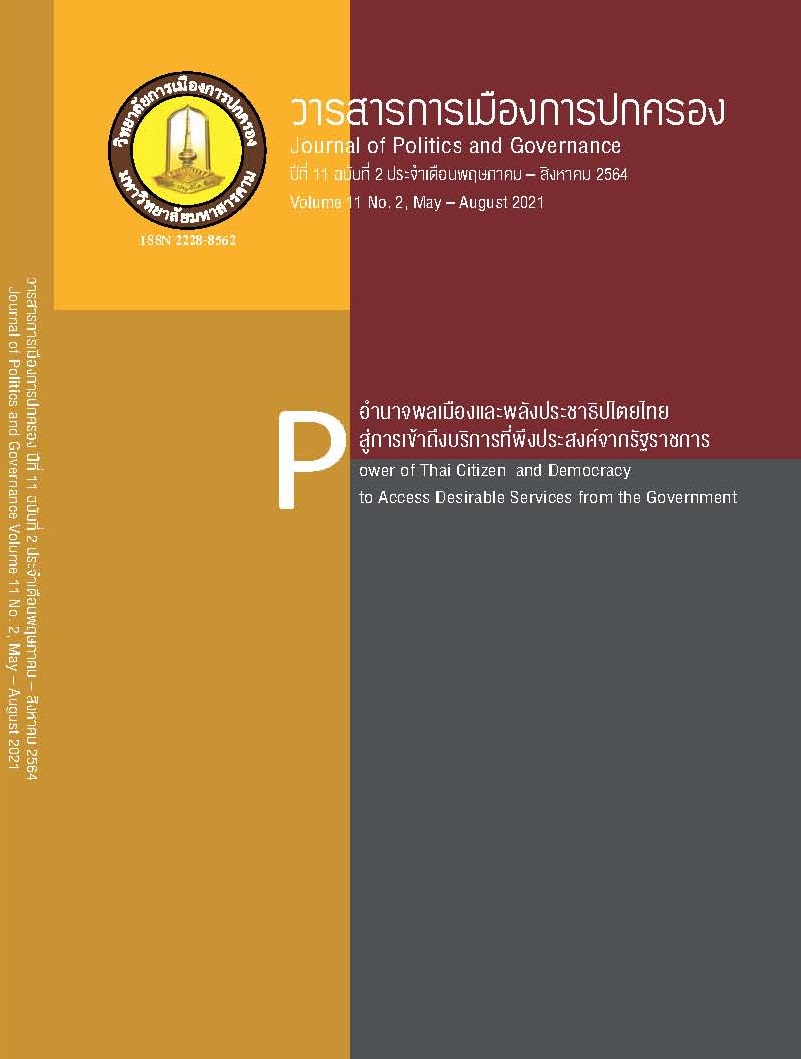Developments Strategies of Mae Sot Frontier Tourism City
Main Article Content
Abstract
This research is a qualitative research. The objective was to develop the development strategies of Mae Sot frontier tourism city. Data collection consists of Documentary Research, In-depth Interview, and Content Analysis. The samples were 5 government officials, 5 tourism operators, 10 people and 30 tourists. The results were as followed; Overview of tourism potential of Mae Sot Municipality, Mae Sot is an outstanding tourism potential area but still lacking of participation from the public, government, and private sectors towards frontier tourism city development. The SWOT analysis showed that the potential of the area is the most important strength. Inversely, the human resource problems is the key weaknesses. In addition, the government's promotion policy is an important opportunity. The border legal problems is a main threat. The developments strategies of Mae Sot frontier tourism city is divided into 3 sub-strategies which are tourism resource development strategy (Source), social development strategy and society quality promotion strategy (Society), and economy strategy (Economy).
Article Details
References
กรมการท่องเที่ยว. (2561). แผนยุทธศาสตร์พัฒนาการท่องเที่ยว พ.ศ. 2561 – 2564 ของกรมการท่องเที่ยว. กรุงเทพฯ: วีไอพี ก็อปปี้ปริ้น.
กองวิชาการและแผนงาน เทศบาลนครแม่สอด. (2562). แผนพัฒนาท้องถิ่น พ.ศ. 2561–2565. แม่สอด: ตาก.
คณะกรรมการนโยบายการท่องเที่ยวแห่งชาติ. (2560). เเผนพัฒนาการท่องเที่ยวแห่งชาติ ฉบับที่ 2 พ.ศ. 2560-2564. กรุงเทพฯ: องค์การสงเคราะห์ทหารผ่านศึก.
คณะกรรมการนโยบายเขตพัฒนาเศรษฐกิจพิเศษ (กนพ.). (2556). เอกสารประกอบการประชุมคณะกรรมการนโยบายเขตพัฒนาเศรษฐกิจพิเศษ (กนพ.) ครั้งที่ 1/2556 เรื่อง การจัดตั้งเขตเศรษฐกิจพิเศษแม่สอดและท้องถิ่นรูปแบบพิเศษนครแม่สอด. 18 กันยายน 2556 ตึกไทยคู่ฟ้า ทำเนียบรัฐบาล.
คมสิทธิ์ เกียนวัฒนา, กฤติกา สายณะรัตร์ชัย, และองค์ บรรจุน. (2561). การบูรณาการทุนวัฒนธรรมเพื่อส่งเสริมการท่องเที่ยวเชิงสุขภาพของน้ำพุร้อนแม่กาษา ด้วยการมีส่วนร่วมของชุมชน. ทีทัศน์วัฒนธรรม, 17(2), 1-18.
จารุจน์ กลิ่นดีปลี. (2541). การประเมินศักยภาพของแหล่งท่องเที่ยวสำหรับการท่องเที่ยวเชิงนิเวศกรณีศึกษา: อุทยานแห่งชาติไทรโยค จังหวดักาญจนบุรี. (ภาคนิพนธ์ปริญญามหาบัณฑิต). สถาบันบัณฑิตพัฒนบริหารศาสตร์.
ณัฏฐกฤษฏิ์ เอกวรรณัง. (2558). เอกสารประกอบการสอนวิชาการพัฒนาและอนุรักษ์ทรัพยากรการท่องเที่ยว. กรุงเทพฯ: มหาวิทยาลัยธุรกิจบัณฑิตย์.
เทศบาลนครแม่สอด. (2558). แผนยุทธศาสตร์การพัฒนา (พ.ศ. 2558 – 2562) เทศบาลนครแม่สอด อ.แม่สอด จ.ตาก. แม่สอด: ตาก.
ธารทิพย์ ธรรมสอน และสมเกียรติ ชัยพิบูลย์. (2553). การวิจัยเชิงปฏิบัติการแบบมีส่วนร่วมของชุมชนในการจัดการสิ่งแวดล้อมเมืองการค้าชายแดนแม่สอด อำเภอแม่สอด จังหวัดตาก. สักทอง: วารสารมนุษยศาสตร์และสังคมศาสตร์, 16(1), 30-43.
ประชาชาติธุรกิจ. (2561). เที่ยวชายแดน “แม่สอด-เมียนมา” บูมโกยรายได้ 6พันล้าน. สืบค้นจาก https://www.prachachat.net/tourism/news-210095
สำนักงานปลัดกระทรวงคมนาคม. (2560). ความร่วมมือด้านการขนส่งอาเซียน. สืบค้นจาก http://eservice.mot.go.th/motportal/Home/AEC2
องค์ บรรจุน. (2561). ค้นเอกลักษณ์แม่สอด จากเมืองผ่านชายแดนการค้าสู่เมืองท่องเที่ยวเชิงประวัติศาสตร์และชาติพันธุ์. การประชุมวิชาการระดับชาติและนานาชาติ ครั้งที่ 5, ขอนแก่น, 1118 – 1198. 21 กรกฎาคม 2561.
อดิเรก ฟั่นเขียว. (2559). ข้อเสนอเพื่อการพัฒนาเขตเศรษฐกิจพิเศษชายแดนในพื้นที่จังหวัดตาก. วารสารด้านการบริหารรัฐกิจและการเมือง, 5(1), 89-125.
John M.C. and Norman T.U. (1977). Rural Participation: Concepts and Measures for Project Design, Implementation and Evaluation. New York, U.S.A.: Cornel University


